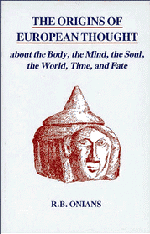Book contents
- Frontmatter
- Contents
- Preface to the first edition
- Preface to the second edition
- Introduction: The Earliest Greeks
- PART I THE MIND AND THE BODY
- Chapter I Some Processes of Consciousness
- Chapter II The Organs of Consciousness
- Chapter III The Stuff of Consciousness
- Chapter IV Cognition—The Five Senses
- Chapter V The Liver and the Belly
- PART II THE IMMORTAL SOUL AND THE BODY
- PART III FATE AND TIME
- ADDENDA
- Indexes
Chapter I - Some Processes of Consciousness
Published online by Cambridge University Press: 06 August 2010
- Frontmatter
- Contents
- Preface to the first edition
- Preface to the second edition
- Introduction: The Earliest Greeks
- PART I THE MIND AND THE BODY
- Chapter I Some Processes of Consciousness
- Chapter II The Organs of Consciousness
- Chapter III The Stuff of Consciousness
- Chapter IV Cognition—The Five Senses
- Chapter V The Liver and the Belly
- PART II THE IMMORTAL SOUL AND THE BODY
- PART III FATE AND TIME
- ADDENDA
- Indexes
Summary
How do Homeric notions of the main processes of consciousness differ from our own? A good deal is explicit. Thinking is described as ‘speaking’ and is located sometimes in the heart but usually in the ϕρήν or ϕρένες, traditionally interpreted as the ‘midriff’ or ‘diaphragm’. To deem, be of opinion, is ϕάναι or ϕάσθαι. Thus the false dream leaves Agamemnon alone, ‘thinking (ϕρονέοντα) in his mind (θυμός) things that were not to be fulfilled. For he deemed (ϕῆ, lit. “said”) he would take Priam's city that very day’. Deep reflection is conversation of one's self with one's θυμός or of one's θυμός with one's self. Thus Menelaos, deserted in battle, ‘spake (εἶπε) to his great-hearted θυμός: “Woe is me if I leave behind these noble arms.… But why did my θυμός thus hold converse (διελέξατο)?… That were choicest of evils”. While thus he pondered (ὥρμαινε) in his θυμός and ϕρήν, the Trojan ranks came on’. This view of thought as speech contributed to the later use of λόγος as equivalent to ratio as well as oratio. Expression may be more or less articulate. As he lay awake, the heart of Odysseus within him barked against the serving maids as a bitch with pups barks savagely at a stranger, but Odysseus ‘smote his breast and rebuked his heart with words: “Endure, O heart; yet a more shameless thing didst thou endure”.
- Type
- Chapter
- Information
- The Origins of European ThoughtAbout the Body, the Mind, the Soul, the World, Time and Fate, pp. 13 - 22Publisher: Cambridge University PressPrint publication year: 1988



